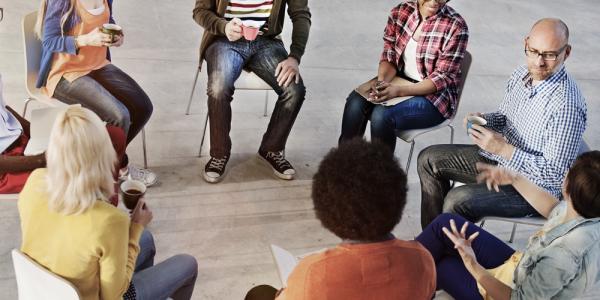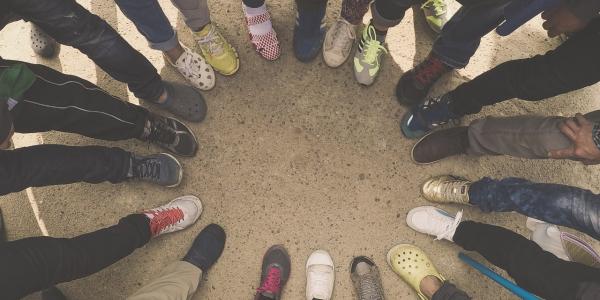Alcoholics Anonymous A.A., it may not be what you think.

The varying formats of A.A. meetings.
You may have heard of Alcoholics Anonymous (A.A.) as it is the most popular support group that features a 12-step format. You may have even seen depictions of what happens at an A.A. meeting on television. Ever catch an episode of Mom on CBS? But as is often the truth, portrayals in film and television are seldom close to what actually happens in the real world. So what actually do A.A. meetings look like?
Well, first of all, it depends on what type of A.A. meeting you find yourself at. A good amount of people do not know this, but A.A. is more than people sharing tales of woe and loss in a smoke-filled room at an Alano Club (Non-profits organizations founded to offer physical locations for A.A. meetings). In fact, there are usually several formats an A.A. meeting can take. The format of the meetings are generally listed on the schedule online or in a brochure at the meeting location. Meeting locations vary from community centers, to churches, to non-profits, or different Alano Clubs. The three main types of meeting formats offered are listed below.
- (B) Beginners Meetings - Topics of discussion are suited to new arrivals in A.A. and typically address the basics of the A.A. program.
- (C) Closed - A closed meeting is for A.A. members and those persons that have a desire not to drink.
- (O) Open Meeting - Open meetings are available to anyone with an interest in A.A. including students, professionals, friends, and family.
A second important thing to know is that the subject matter of meetings can vary as well. The following are some typical subjects that can take place in either open, closed, or beginner meetings.
- Big Book- The book “Alcoholics Anonymous”, affectionately referred to as The Big Book, is the text used for these types of meetings. This Big Book consists of over 500 pages that focus on the A.A. founders’ experience with alcoholism, as well as the solutions they developed for recovery known as the Twelve Steps. In these meetings, members will read and discuss the text. Sometimes, each member reads a paragraph in turn, and the book gets read in sequence for several pages — possibly a half chapter at a time. After a reading, members share their experience or thoughts on the material they just read.
- Step Meetings- Using the book Twelve Steps and Twelve Traditions, the subject of these meetings focus on steps. The steps are originally outlined in Chapter 5, “How It Works,” of the Big Book. The Twelve Steps focus on how to achieve and maintain abstinence from alcohol. Generally, a new step is read and discussed each week by the group. Sometimes, one person goes through the Twelve Steps and shares their experience with each step over the course of 12 weeks with the group.
- Speaker Meetings- For these meetings, a speaker is selected in advance who agrees to "tell their story" of drinking and recovery to the group. Speakers are usually members with more than a year of sobriety who have previously been asked and agreed to speak. Speaker meetings often devote the entire meeting to the speaker's story. When the story is finished the meeting is wrapped up without formal discussion.
- Speaker-Discussion Meetings- These meetings combine a speaker and discussion. Generally a chosen speaker talks for about half of an hour followed by a group discussion related to the topic that was presented.
- Discussion Meetings- Last but not least, these are the type of meetings that are often dramatized in film and television. Discussion meetings often start with the leader briefly introducing a topic and then for the duration of the meeting, individual members will share about that topic. This is when the common introduction "My name is so-and-so and I am an alcoholic." can happen. However, individuals are not forced to identify as an alcoholic. Also, individuals are not forced to share and it is completely acceptable to say “Thanks, I'll pass" or "I'll just listen tonight." And just so you know, there are non-smoking discussion meetings that take place as well, even though we don’t see them in the movies.
A final mention for this article is that other meetings are created for specified segments of the recovery community. Some examples of those include meetings specifically for men, women, young people, veterans, gays, and lesbians, as well as Native Americans and individuals who speak Spanish. To find a meeting that’s right for you, or if you want to learn more about A.A., or are interested in attending a meeting check out their website.
If you are an MSU employee, spouse, or benefits-eligible family member of an MSU employee and would like to discuss AA, the 12-step format, or recovery for that matter, please feel free to contact the MSU Employee Assistance Program to schedule a discussion with a licensed professional today.
Related Articles









